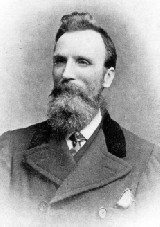Henry Dyer
| Henry Dyer | |
|---|---|
 Henry Dyer | |
| Born |
August 16, 1848 Bellshill, North Lanarkshire, Scotland |
| Died |
September 25, 1918 (aged 70) Glasgow, Scotland |
| Nationality | Scottish |
| Occupation | engineer, educator |
Henry Dyer (August 23, 1848 – September 25, 1918) was a Scottish engineer who contributed much to founding Western-style technical education in Japan and Anglo-Japanese relations.
Early life
Henry Dyer was born on 16 August 1848, in the village of Muirmadkin (now absorbed into the town of Bellshill) in the Parish of Bothwell in what is now known as North Lanarkshire.
Around 1865, the Dyer family moved to Glasgow where Henry was employed at James Aitken and Company's foundry in Cranstonhill. There he served his apprenticeship as a student engineer under Thomas Kennedy and A C Kirk. At the same time, he attended classes at Anderson's College (later to become the University of Strathclyde) together with Yamao Yōzō.
Dyer studied at Glasgow University from 1868. He was the first Scot to win the Whitworth scholarship awarded in 1868, which was for the further instruction of young men gifted in the practice and theory of mechanics. Henry Dyer graduated from Glasgow University in 1873 with a "certificate in proficiency in engineering", the forerunner of the BSc in Engineering, from the Engineering department.
Japan (1873–1882)
Dyer was recommended to Itō Hirobumi during the Iwakura Mission's visit to the United Kingdom for the post of Principal and Professor of Engineering at the new Imperial College of Engineering (ICE or Kobu Daigakko) in Tokyo by his professor, William John Macquorn Rankine and appointed in 1872 when just 25 years old.
The Government of Japan at the time was actively seeking to transfer skills and knowledge from the United Kingdom and other countries in order to catch up with them. The courses Dyer implemented at the ICE required the student to spend two years on general and science subjects, two on technical subjects in the student’s chosen field, and two more on purely practical work.
To provide practical training, Dyer helped set up the Akabane Engineering Works, the largest in the Empire of Japan. Many of the major engineering works carried out in Japan at the end of the 19th century were by his former students, and Dyer also sent many to Glasgow to complete their education.
When he left the ICE in 1882, Dyer was made Honorary Principal and Emperor Meiji awarded him the Third Class of the Order of the Rising Sun, the highest Japanese honour available to foreigners. He had established a progressive system of engineering education in Tokyo and greatly contributed to the progress Japan made as an industrial power.
Returning from Japan, Henry Dyer brought back various Japanese artefacts and art works, some of which were later donated by his descendants to the Mitchell Library, Glasgow and Edinburgh Central Library. Included in the bequest to Edinburgh Central Library donated by Dyer's daughter Marie Ferguson Dyer, is the painted handscroll Theatres of the East by the Japanese artist Furuyama Moromasa,[1] loose Japanese woodblock prints, bound woodblock printed volumes, bound volumes of paintings, and a collection of nineteenth century Japanese photographs attributed to Franz von Stillfried-Ratenicz.[2]
Scotland (1882–1918)
Henry Dyer went back to Scotland and in 1886 became a life governor of the Glasgow and West of Scotland Technical College (previously Anderson's College, where he had been a student, and later to become the University of Strathclyde, and governor of the Glasgow and West of Scotland Agricultural College. He became a member of the Glasgow School Board in 1891 and was its president from 1914 until his death.
Dyer represented a tireless pro-Japanese lobby within Scotland. He assisted Japanese students, engineers and trainee managers and had a staunch ally in Captain A R Brown of the company Brown, McFarlane who had been responsible for taking the first Clyde-built ships to Japan. Dyer worked as an unofficial liaison officer for the Japanese Government in Glasgow and thanks to his efforts Glasgow University Court permitted Japanese as a language for entry in 1901. In the same year Professors Jōji Sakurai and Isao Iijima of the Tokyo Imperial University were awarded honorary degrees during the University’s Ninth Jubilee celebrations.
The University of Strathclyde's Henry Dyer Building, home to the Department of Naval Architecture and Marine Engineering, was named after him.
In 2015 he was inducted into the Scottish Engineering Hall of Fame[3]
Family
Married 23 May 1874, Marie Euphemia Aqaurt Ferguson, eldest daughter of Duncan Ferguson of Glasgow at the British Legation in Yokohama, Japan.[4]
Publications
- The Evolution of Industry (1895)
- Dai Nippon: The Britain of the East (1904)
- Japan in World Politics (1909)
- Collected Writings of Henry Dyer, in 5 vols., edited by Nobuhiro Miyoshi, Tokyo: Edition Synapse. ISBN 978-4-901481-83-0
See also
References
- ↑ "Early 18th Century Japanese Scroll". Capital Collections. Retrieved 26 Feb 2016.
- ↑ edinburghcitylibraries. "The people who helped shape Edinburgh Libraries: Henry Dyer". Tales of One City. Retrieved 2016-02-26.
- ↑ http://engineeringhalloffame.org/ accessed 4 October 2015
- ↑ "Mail Summary: Married". The Japan Gazette. 5 June 1874.
- Olive Checkland, 'Henry Dyer at the Imperial College of Engineering Tokyo, and afterwards in Glasgow', Chapter 11, Britain & Japan: Biographical Portraits, Volume 3, Japan Library, ISBN 1-873410-89-1
- Collected Writings of Henry Dyer, ISBN 1-901903-71-0
- Henry Dyer: Pioneer of Education in Japan, by Nobuhiro Miyoshi, 2004, ISBN 1-901903-66-4
External sources
- Henry Dyer, 1848-1918 - a detailed and informative site
- Japan and People
- Japan and Shipbuilding
- Glasgow University and Japan
- - Henry Dyer Building, University of Strathclyde